Physical Address
304 North Cardinal St.
Dorchester Center, MA 02124
2–5 million eccrine glands are unevenly distributed over the skin surface
In healthy individuals, eccrine sweat is 99% water
Sweating is a reflex sympathetic autonomic function mediated by cholinergic neurons
In humans, sweating is essential for thermoregulatory homeostasis. There are two main mechanisms for cooling the body: radiative cooling via cutaneous vasodilation and evaporative cooling via sweat. Sweat, primarily produced by the eccrine sweat glands, leads to dissipation of heat through evaporation. Few mammals except humans and horses produce sweat in sufficient quantities to affect thermoregulation. For the purposes of this discussion, the term “sweat” applies to eccrine glands and their secretory products unless otherwise specified.
Although there are 2–5 million eccrine glands distributed within the skin, none are found on the clitoris, glans penis, labia minora, external auditory canal, or lips. Eccrine glands are separate from the apocrine-pilosebaceous apparatus, and by dermoscopy, eccrine ductal orifices can be seen along the dermatoglyphic ridges of the palms and soles. The average healthy adult can produce over 0.5 liters of sweat per hour, 99% of which is water. Athletes or those acclimatized to hot environments can produce up to 3–4 liters per hour . Physically fit or acclimatized persons initiate sweating earlier and conserve sodium, chloride, and other electrolytes more efficiently. Thermoregulatory control is similar in men and women and diminishes only slightly with age .
Sweating is a reflex function controlled primarily by the sympathetic nervous system. These nerves are anatomically sympathetic but functionally cholinergic, i.e. acetylcholine, rather than norepinephrine, is the principal terminal neurotransmitter. Neural impulses for sweating (sudomotor impulses) travel from the anterior hypothalamus via the reticulospinal tracts to the appropriate level in the spinal cord, out through the rami communicantes to autonomic ganglia, and then within sympathetic cholinergic neurons to the secretory cells of the eccrine glands. Adrenergic innervation of eccrine glands has also been demonstrated, but is not believed to be physiologically important . In addition, the sweat glands, via a direct effect on the secretory cells, respond to certain drugs (e.g. cholinergic agonists) as well as to the local application of heat.
In humans, apocrine sweat glands are confined to the eyelids (Moll's glands), external auditory meatus, axillae, areola and nipple, periumbilical region, and anogenital region, in particular the mons pubis, labia minora, prepuce, scrotum, and perianal area. At five months gestation, apocrine glands are distributed all over the body, whereas in a full-term neonate they are limited to the above sites. In non-primate mammals, apocrine sweat glands are widely distributed but they also open into the pilosebaceous unit.
Apocrine secretion is a slow, usually continuous process analogous to milk formation in the mammary gland. The secretory product is an oily fluid composed of lipids, proteins, and sex hormones. At or near the skin surface, it mixes with sebum derived from the sebaceous gland that empties into the same pilosebaceous unit.
Excessive sweating
Primary hyperhidrosis is the most common type, typically affecting the palms, soles, and/or axillae
Secondary hyperhidrosis is due to an underlying condition (e.g. genetic syndrome, infection, tumor) or medication and may be localized or generalized
Hyperhidrosis is estimated to affect 3% of the US population . The most widely used classification system divides it into primary and secondary types. Other classification systems separate hyperhidrosis into categories based on the source of the neural impulses that drive it: cortical (emotional), hypothalamic (thermoregulatory), medullary (gustatory), spinal cord, and local axon reflexes.
▪ Primary focal hyperhidrosis
Main sites are volar (palms, soles) and axillary skin; the face may also be involved
Hyperhidrosis arises from increased cortical stimulation and occurs only during waking hours (diurnal)
Patients are otherwise healthy
Up to 80% of affected individuals have a family history of hyperhidrosis
Primary hyperhidrosis, the most common type of hyperhidrosis, is defined as excessive sweating in localized areas (usually the palms, soles, and/or axillae) and is not associated with a systemic disorder. Men and women of all races are equally affected. Table 39.1 lists the diagnostic criteria . Between 60% and 80% of patients with primary hyperhidrosis have a family history , with a pattern of inheritance suggesting autosomal dominant transmission with incomplete penetrance. A locus for primary palmar hyperhidrosis was mapped to chromosome 14q in three Japanese families .
| CRITERIA FOR THE DIAGNOSIS OF PRIMARY HYPERHIDROSIS |
|
Intense emotion or stress can elicit sweating in anyone. It occurs most often on the palms, soles, or axillae and can also affect the face ( Fig. 39.1 ), especially the forehead and the cutaneous upper lip. The post-orgasmic sweating observed with sexual activity may also derive from emotional stimulation .
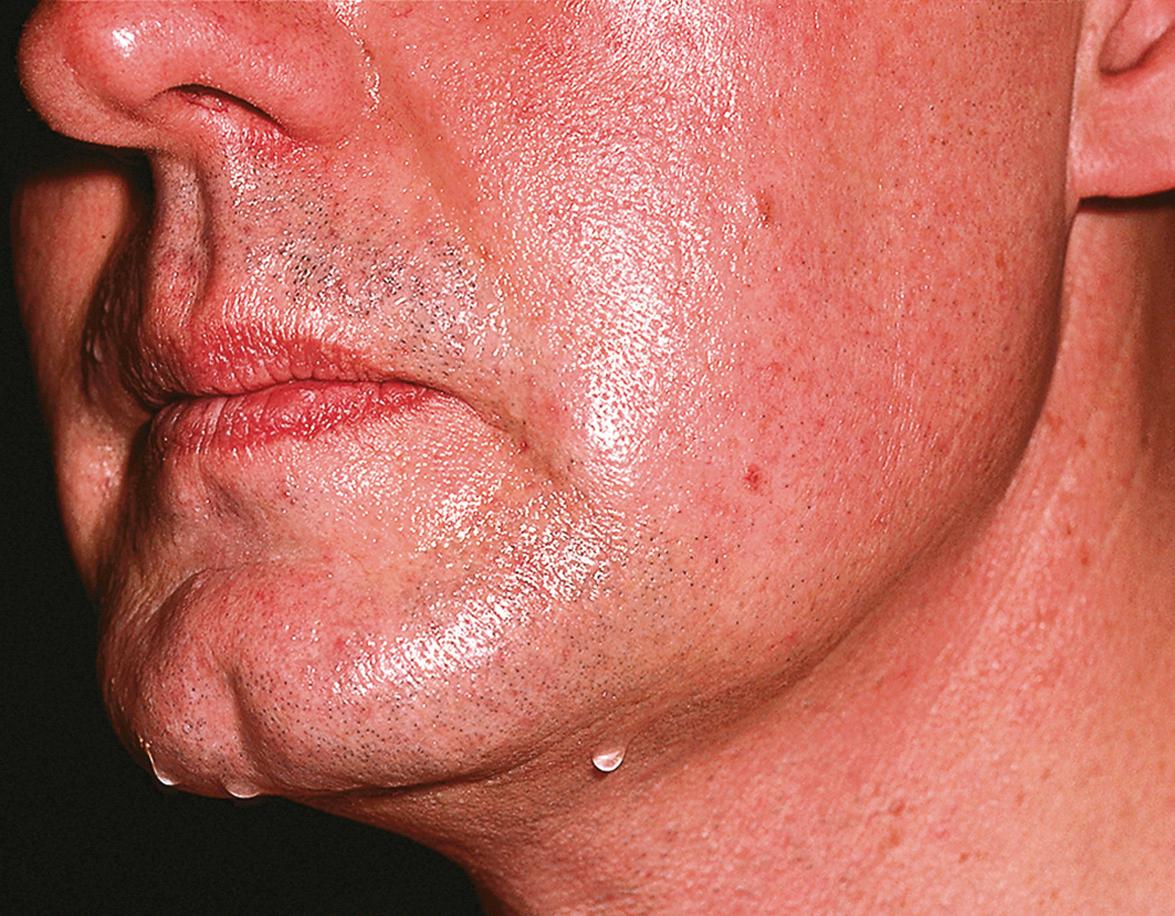
Clinically significant primary hyperhidrosis occurs in two major patterns: volar (palmoplantar) and axillary, which can coexist , but usually one of the two sites predominates. The onset of volar hyperhidrosis is often during childhood, whereas axillary hyperhidrosis typically develops at or soon after puberty. Primary hyperhidrosis is seen in both cold and warm environments. A chronic and unremitting course is characteristic, with little or no variation in association with age, disease, or hormonal status.
Volar hyperhidrosis is the most common form of primary hyperhidrosis ( Fig. 39.2 ), affecting ~50–60% of patients . The entire palm and sole, as well as the lateral aspects, tips and distal dorsal skin of the fingers, display sweating. It can clearly have an impact on quality of life.
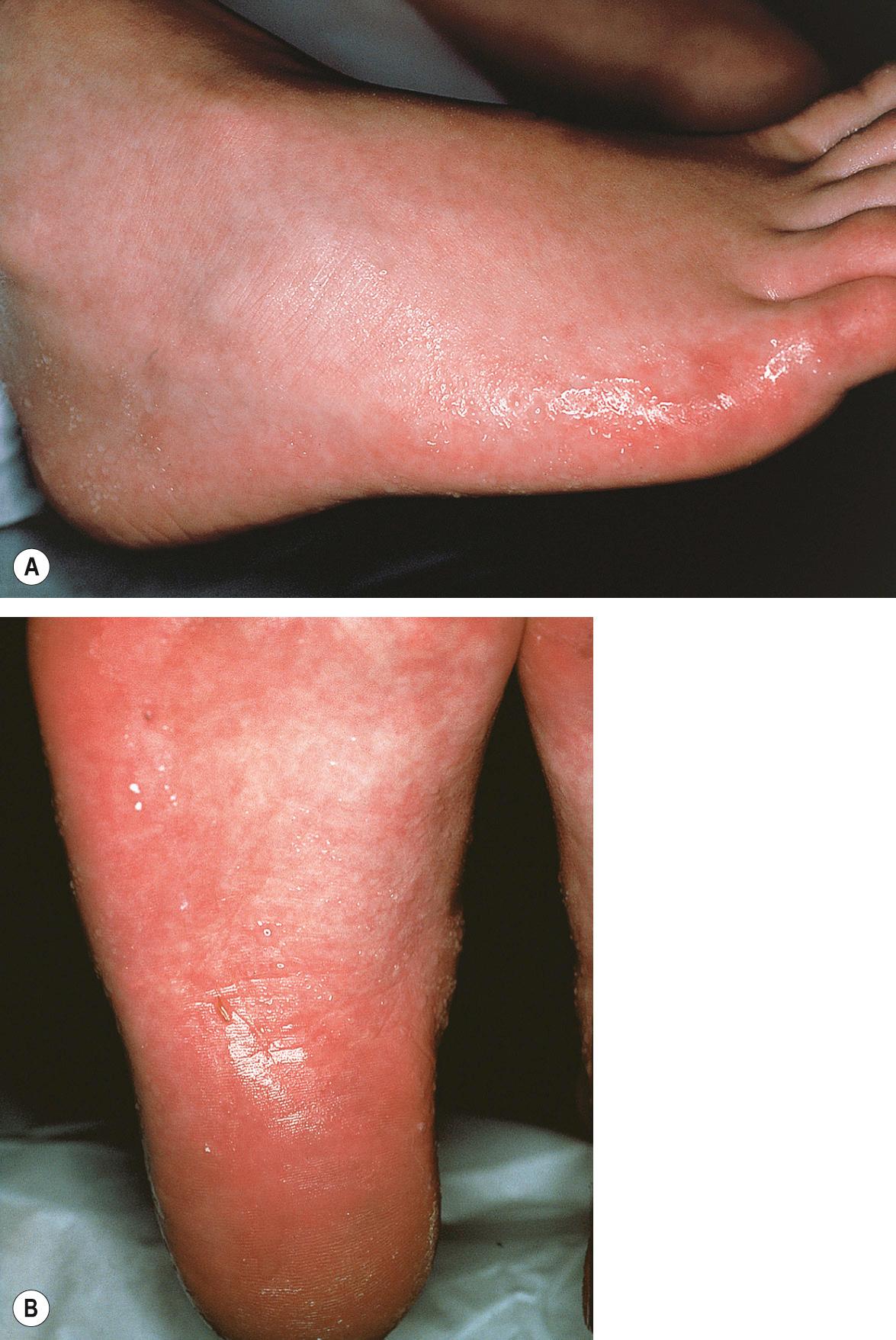
Axillary hyperhidrosis is the second most common form of primary hyperhidrosis, affecting 30–50% of patients . The right axilla usually produces more sweat than the left (60 : 40). Exceptionally, one axilla may be hyperhidrotic while the opposite axilla is hypohidrotic or virtually anhidrotic. Odor (axillary bromhidrosis) is usually absent; the excessive quantities of eccrine sweat presumably rinse away or dilute odorogenic apocrine sweat droplets and bacteria.
Secondary hyperhidrosis is caused by or associated with another systemic disorder. It may be localized or generalized. There are many causes, which can be divided into categories based on the source of the neural impulse driving the response: cortical, hypothalamic, medullary, spinal cord, or local. A number of medications may also be associated with hyperhidrosis ( Table 39.2 ).
| DRUGS THAT CAN STIMULATE ECCRINE SWEATING | |
|---|---|
| Direct-acting cholinomimetic agents | |
|
|
| Cholinesterase inhibitors | |
|
|
| Adrenomimetic agents | |
|
|
| Antidiabetic (hypoglycemic) agents | |
|
|
| CNS stimulants | |
|
|
| Antidepressants | |
|
|
| Antipsychotics | |
| Antipyretics | |
| Opioids | |
| Other drugs | |
* Increased sweating is infrequently observed at pharmacologic doses but represents a sign of overdose.
† Combination of MAOIs (which include linezolid as well as antidepressants) with drugs such as tricyclics, SSRIs, certain opioids and tryptophan can result in the serotonin syndrome, which is characterized by mental status changes, autonomic hyperactivity (including hyperhidrosis), and neuromuscular abnormalities.
Several disorders of cornification and other genodermatoses affecting palmoplantar skin are associated with volar hyperhidrosis
Patients with hereditary autonomic neuropathies can also exhibit cortical hyperhidrosis
Isolated sweating of the palms and soles is primarily due to cortical excitation by emotional or sensory stimuli. Excessive volar sweating associated with certain inherited palmoplantar keratodermas is assumed to be cortical in nature, although the pathogenic relationship between the abnormal keratinization and hyperhidrosis has not been precisely delineated. Many palmoplantar keratodermas are malodorous, likely related to sweat-induced maceration of the thickened stratum corneum and bacterial degradation of keratin. Other genodermatoses affecting the volar skin, such as epidermolysis bullosa simplex, can also have associated palmoplantar hyperhidrosis. Additional causes of cortical hyperhidrosis are listed in Table 39.3 .
| CAUSES OF CORTICAL (STRESS/EMOTIONAL) HYPERHIDROSIS |
| Primary hyperhidrosis |
| Secondary hyperhidrosis |
| Disorders of cornification |
|
| Other genodermatoses |
|
| Hereditary sensory and autonomic neuropathies (HSANs) † |
|
Due to elevated body temperature (e.g. acute febrile illness, lymphoma, chronic infection) or direct hypothalamic stimuli (e.g. pheochromocytoma, medications, toxins)
May be nocturnal (night sweats) or diurnal
The hypothalamus is responsible for many autonomic activities, including thermoregulation. Elevation of the temperature of the blood by 0.5°F or more excites the hypothalamic nuclei and results in vascular dilation and generalized sweating responses aimed at dissipating body heat .
Febrile illnesses are among the most common pathologic states that cause hypothalamic sweating. At the height of the fever, notably with temperatures of 39–40°C (102–104°F) or above, sweating is absent, the apparent result of inhibition of the hypothalamic center for sweating. With defervescence, sweating characteristically ensues. Lymphomas and chronic infections (e.g. tuberculosis) can present with episodic thermoregulatory sweating, which may be described as “night sweats” (that actually follow unperceived mild febrile pulses).
Generalized sweating of hypothalamic origin can also be seen in a number of metabolic and endocrine disorders ( Table 39.4 ). Patients with diabetes mellitus may exhibit hypohidrosis as well as various forms of hyperhidrosis. For example, hyperhidrosis is a characteristic sign of insulin-induced hypoglycemia (but not diabetic ketoacidosis), and compensatory hyperhidrosis of the trunk can develop in the setting of diabetic neuropathy affecting the extremities (see below). In addition, diabetics may exhibit gustatory hyperhidrosis, primarily of the face and neck. Troublesome sweating of the scalp can also be seen in poorly controlled diabetics, and, with regulation of the hyperglycemia, the hyperhidrosis often improves.
| CAUSES OF HYPOTHALAMIC HYPERHIDROSIS | ||||||
|---|---|---|---|---|---|---|
| Infection | Tumors | Endocrine/metabolic | Vasomotor | Neurologic | Drugs/toxins | Miscellaneous |
|
|
|
||||
* Via release of catecholamines (pheochromocytoma) and serotonin (carcinoid tumors, usually metastatic; see Ch. 106 ).
† Patients have sympathetic activation, with impaired vasodilatory responses to heating but preserved sweating.
‡ Also associated with cortical hyperhidrosis.
§ Referred to as Hines–Bannick syndrome or, when associated with agenesis of the corpus callosum, Shapiro syndrome.
∥ Autosomal recessive condition caused by mutations in the genes encoding cytokine receptor-like factor-1 and cardiotrophin-like cytokine factor-1; additional features include facial dysmorphism, flexion deformities (elbows, fingers), and scoliosis.
¶ Compensatory hyperhidrosis is also a feature of Ross syndrome (segmental anhidrosis, generalized areflexia and tonic pupils).
Disorders with vasomotor instability, such as Raynaud phenomenon, autoimmune connective tissue diseases, frostbite and other cold injuries, and reflex sympathetic dystrophy, may be associated with excessive sweating because of disturbed autonomic function . A synchronous discharge of vasoconstrictor and sudomotor impulses evokes a “cold sweat”, usually of the hands and feet, producing macerated, soggy wet, violaceous skin known as symmetrical lividity.
Cerebral cortex lesions, such as a tumor, abscess or cerebrovascular accident, may be associated with a contralateral hyperhidrosis due to an impairment of the inhibitory cortical influence that normally regulates hypothalamic sudomotor activity . Hypothalamic sweating is also observed in Parkinson disease and occurs as the “sweating sickness” following encephalitis. Harlequin syndrome, characterized by unilateral flushing and hyperhidrosis in association with contralateral anhidrosis, may be due to peripheral or central nervous system (CNS) abnormalities .
Episodic release of catecholamines from pheochromocytomas directly stimulates the hypothalamus and may elicit sweating . Exposures to toxins and medications can also lead to hypothalamic hyperhidrosis, and a number of drugs that act on the CNS have increased sweating as a potential side effect (see Table 39.2 ). Additional causes of hypothalamic hyperhidrosis are presented in Table 39.4 .
Pressure and postural hyperhidrosis may be due to hypothalamic or possibly cortical stimulation. With changes in posture or the application of pressure to one side of the supine individual, a variety of sweating patterns have been described, such as lateral hyperhidrosis, horizontal hemihidrosis, and crossed hemihidrosis. Idiopathic localized unilateral hyperhidrosis of the face and neck or forearm has been reported as an episodic disorder triggered by heat, emotional, or gustatory stimuli .
Taste receptors in the mouth are the source of the afferent impulses that stimulate sweating
Physiologic medullary hyperhidrosis is most commonly triggered by spicy foods, alcohol, and citrus fruits
Pathologic medullary hyperhidrosis occurs when disrupted nerves for sweat aberrantly connect with nerves for salivation; this can be caused by local injury to, or disease of, the parotid gland (Frey syndrome), trauma to the sympathetic trunk, and CNS disorders (e.g. encephalitis, syringomyelia)
Any food or drink that stimulates the taste buds may induce sweating in normal individuals, particularly of the face. This is thought to occur via a variant reflex arc in which afferent impulses from taste bud receptors travel via the glossopharyngeal nerve to nuclei within the medulla oblongata (hence the term “medullary” hyperhidrosis), but lead to provocation of sweating rather than (or in addition to) the usual response of salivation. A few minutes after ingestion of a stimulating food or beverage, sweating and erythema are seen most commonly on the upper cutaneous lip or cheeks. It may be unilateral or bilateral and may be brief or persist as long as the stimulating food or beverage is ingested. Associated vasodilation localized to the areas of sweating causes the erythema, which may be faint. Spicy or sharp-tasting foods and beverages, such as citrus fruits, alcohol and condiments, may elicit the reaction. It is most common in children and young adults and in warmer environments. A familial tendency has been described . There are no other concurrent local or systemic signs or symptoms. A variant of gustatory hyperhidrosis can occur on the face in diabetics. Unusual types of gustatory hyperhidrosis involving the scalp and the knee have also been described and support the concept of a central medullary mechanism for these sweating responses .
This disorder arises after disruption of nerves. During healing, nerve fibers mediating sweating aberrantly connect to nerves that mediate salivation. Impulses in parasympathetic fibers normally supplying the salivary glands are now misdirected to the sweat glands. As a result, salivary stimulation elicits sweating. Of note, thermal sweating in the areas of affected skin is reduced.
The parotid form appears weeks to months following surgery, trauma, or other disorder (e.g. abscess, herpes zoster) affecting the parotid gland. These patients experience vasodilation and sweating on the cheek and adjacent neck when salivary stimulation is induced by eating, drinking, or even chewing ( Fig. 39.3 ). Sweating most often occurs in the distribution of the auriculotemporal nerve; at times there is also unilateral localized pain .
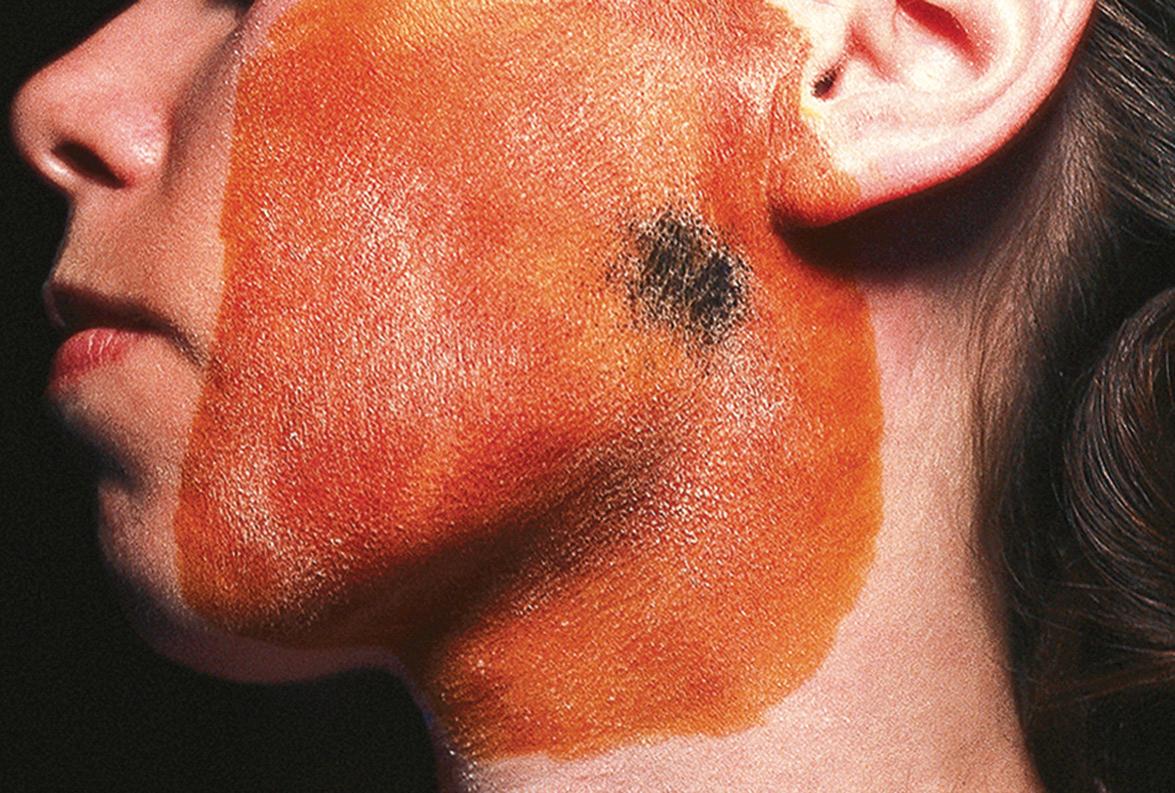
Auriculotemporal syndrome (Frey syndrome) is common after parotid surgery, developing in 40% or more of patients, although many are not aware of it. It can also occur during infancy (frequently as a consequence of trauma to the parotid region in a forceps-assisted delivery), presenting with gustatory flushing, but usually no obvious sweating, that is often erroneously attributed to food allergy. Another variant of gustatory hyperhidrosis is the chorda tympani syndrome in which salivary stimuli to the submandibular gland induce sweating on the chin and lower jaw line.
Patients with cluster headaches can have sympathetic deficits that result in impaired thermoregulatory sweating on the affected side of the forehead. In addition, ipsilateral hyperhidrosis and flushing may occur together with excessive lacrimation during headache attacks. This is due to misdirection of parasympathetic fibers, which normally supply the lacrimal glands, to sweat glands and blood vessels. Patients with Raeder syndrome (Horner syndrome [ptosis, meiosis ± anhidrosis] plus unilateral temporofrontal headaches and pain) may also have excessive supraorbital sweating (lacrimal sweating).
Any condition that injures the vagus nerve and sympathetic trunk, as they lie close together in the thorax, may cause a pathologic medullary hyperhidrosis ( Table 39.5 ). Cholinergic fibers from the vagus nerve sprout into the adjacent sympathetic trunk during the healing process and can result in a gustatory hyperhidrosis with sweating on the face, neck, and portions of the trunk and upper extremities.
| OTHER CAUSES OF SECONDARY HYPERHIDROSIS | |||
|---|---|---|---|
| Medullary (gustatory) | Spinal cord | Axon reflex | Abnormal blood vessels or eccrine glands (non-neural) |
|
|
|
|
In patients with syringomyelia or encephalitis, gustatory hyperhidrosis is occasionally seen on the face and upper trunk. It involves the glossopharyngeal and vagus nerves. Disturbances in the brainstem apparently lead to transposition of the central medullary nuclei for salivation and sweating. There is no peripheral crossing of sympathetic and parasympathetic nerve fibers as is seen in other forms of pathologic gustatory hyperhidrosis.
Spinal disorders may result in a lack of thermal sweating below the injury as well as unusual patterns of hyperhidrosis
Mass reflex sweating may occur around the injured level
Any injury or disease process that severs or interferes with the reticulospinal tracts of the cord can disrupt the sweating reflex (see Table 39.5 ). Lack of a sweat response to thermal stimulation usually occurs below the level of the injury. Abnormal patterns of segmental sweating may occur in conjunction with other autonomic, sensory, and motor alterations. Onset and duration are unpredictable. Sweating can be excessive, drenching the patient in the regions involved. Bouts of “mass reflex sweating” are initiated in the skin below the level of the cord interruption. It is most intense in skin segments close to the level of the transection. Mass reflex sweating does not occur in transections below T8–T10.
Direct stimulation (e.g. electrical, physical, or drug-induced) of a sympathetic axon can cause sweating
May be seen with inflammatory skin diseases
Autonomic dysreflexia is a syndrome that may occur with spinal injuries at or above T6 . Massive episodic sympathetic discharge results in sweating above the level of the transection accompanied by headache, hypertension, facial flushing, bradycardia or tachycardia, piloerection, and paresthesias.
Direct stimulation of a cutaneous sympathetic axon with electrical and physical impulses or injections of drugs with nicotine-like effects on autonomic ganglia can induce sweating in an area ~4 cm in diameter . Mediators from inflammatory skin conditions (e.g. psoriasis, dermatitis) can also elicit localized hyperhidrosis. Substance P and a number of other mediators, including kinins, dopamine, prostaglandins, angiotensin and adenine, may be involved .
Anhidrosis in one area may cause hyperhidrosis in another
Miliaria, diabetic neuropathy, and sympathectomy are well-known causes
The coordinated functioning of the body's eccrine sweat glands is illustrated by the phenomenon of compensatory hyperhidrosis, in which the sweat glands of one area become hyperactive in an effort to compensate for hypo- or anhidrosis in another. Apparently, a threshold number of sweat glands must be non-functional in order for the compensatory response to occur. The nature or type of the underlying process that produces the anhidrosis also appears to be important. For example, compensatory hyperhidrosis does not seem to develop secondary to the anhidrosis produced by lymphomas.
The best-known clinical forms of compensatory hyperhidrosis occur in the following three situations:
Miliaria : longstanding or recurrent miliaria rubra or profunda typically results in numerous non-functional sweat glands within large areas of the trunk. This induces compensatory hyperhidrosis of the face ( Fig. 39.4A ), especially in response to ambient heat or exercise.
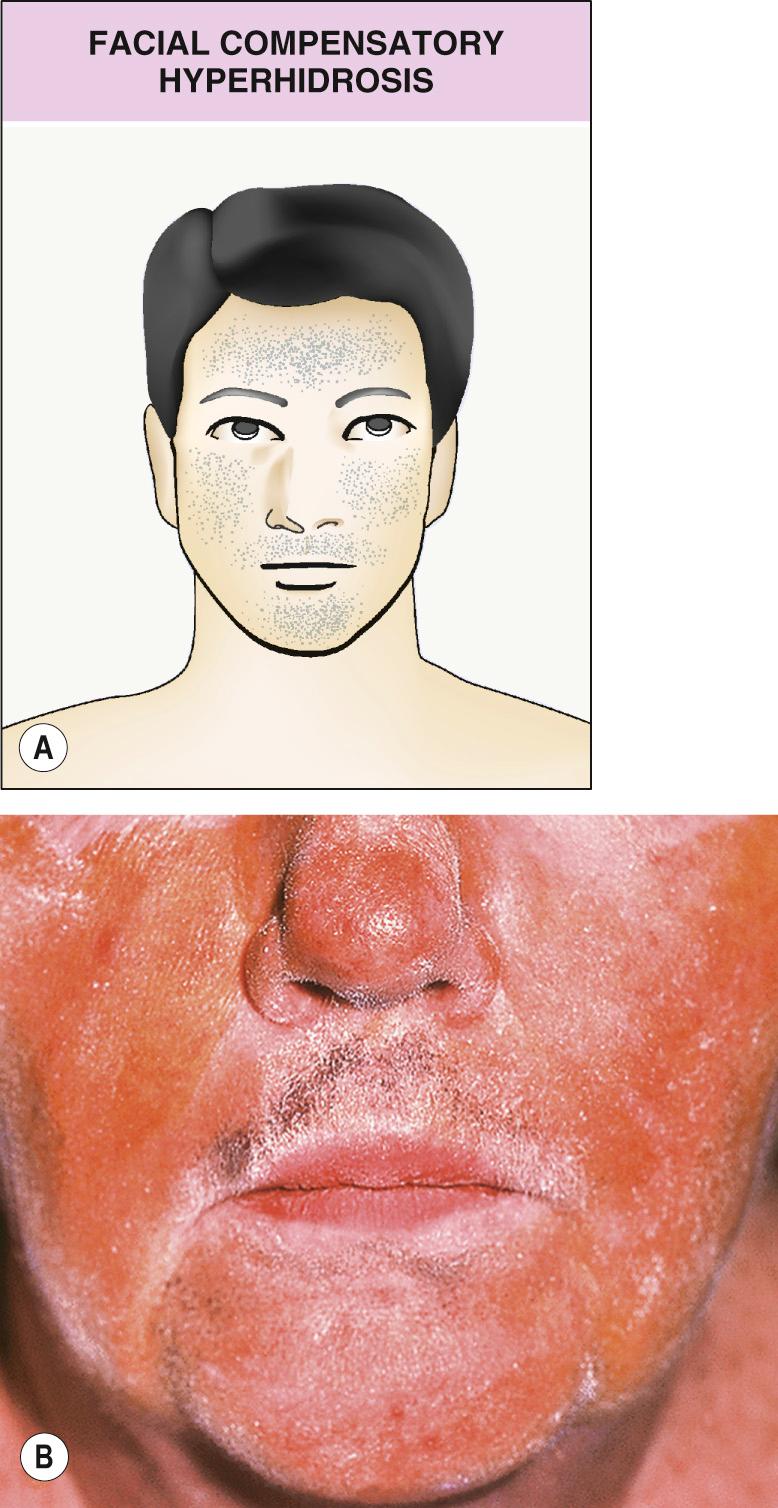
In diabetes mellitus , disturbance of the autonomic nervous system due to peripheral neuropathy and microangiopathy often causes anhidrosis or hypohidrosis of the affected skin, particularly the legs. With the loss of sweating on the lower extremities, these patients may develop compensatory increases in thermal sweating on the trunk, especially the back. A second type of compensatory hyperhidrosis, gustatory in character and usually on the face and neck ( Fig. 39.4B ), may also be seen in diabetic patients with peripheral neuropathy of the lower extremities.
Post-sympathectomy : with the loss of sweating that results from cervicothoracic sympathectomies, a thermal hyperhidrosis, usually on the trunk, is common. Sympathectomized patients may also experience gustatory hyperhidrosis.
Direct stimulation of eccrine glands can cause sweating
Triggers include local heat, drugs, and vascular tumors
Direct stimulation of eccrine sweat glands by heat or sudomimetic drugs can lead to localized sweating. Even denervated skin sweats when heat is applied . Table 39.5 outlines additional non-neural causes of localized hyperhidrosis, including increased activity of eccrine glands overlying vascular lesions such as eccrine angiomatous hamartoma ( Fig. 39.5 ). The rare disorder “cold erythema” affects the skin and gastrointestinal tract – exposure to cold produces local cutaneous erythema and intense pain along with a central area of hyperhidrosis. As with other entities in which local pain is a clinical feature (e.g. glomuvenous malformations), increased blood flow or an axon reflex (secondary to the pain) may be the casual mechanism for this sweating.
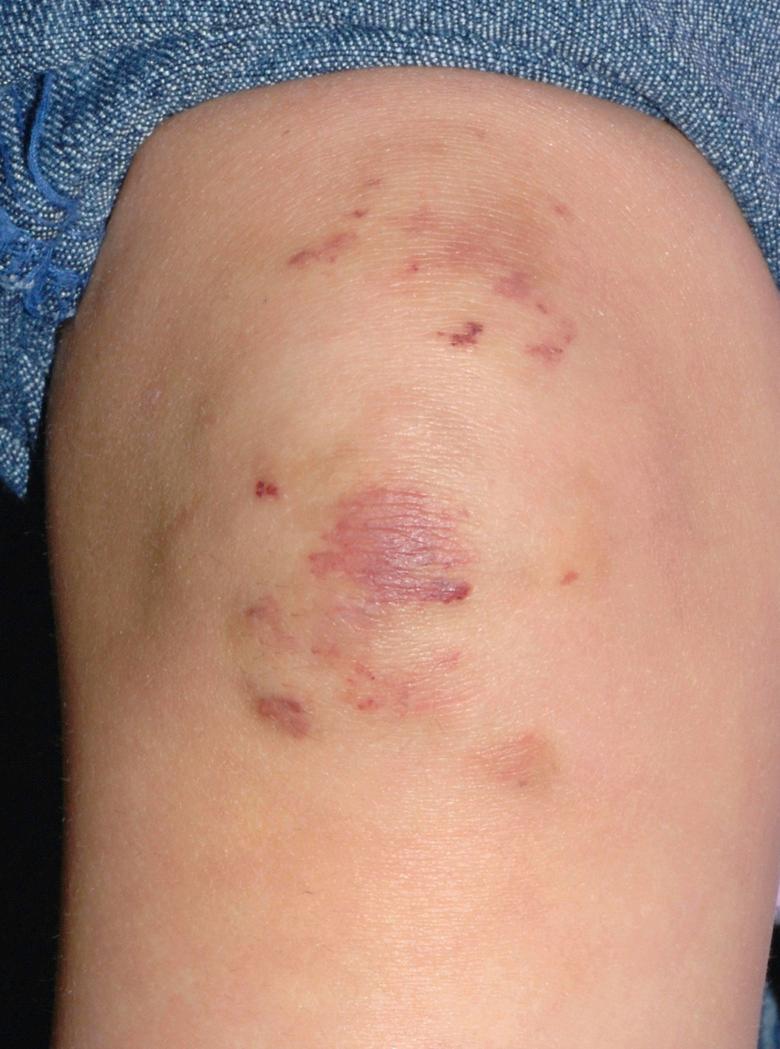
Differentiation between primary and secondary hyperhidrosis is important
Hyperhidrosis can be documented by colorimetric and gravimetric methods
The first step is to differentiate between primary and secondary hyperhidrosis. History will elicit location, duration, and specific triggers. Other medical disorders and medications (including over-the-counter products) need to be ascertained. An extensive review of systems should point to any secondary causes.
Patients who do not fit the classic pattern of primary hyperhidrosis (see Table 39.1 ) should undergo further evaluation, focusing on possible etiologies (see Tables 39.2–39.5 ) during a complete history and physical examination. Laboratory testing and radiographic studies may be needed ( Table 39.6 ).
| INITIAL PATIENT EVALUATION FOR SECONDARY HYPERHIDROSIS | |
|---|---|
| Laboratory test | Disease |
| Serum electrolytes, BUN, creatinine | Renal disease (rare) |
| Fasting blood glucose level and/or HbA1c | Diabetes mellitus |
| Thyroid function tests | Hyperthyroidism |
| Skin and/or blood tests for tuberculosis (e.g. PPD, QFTB-G) | Tuberculosis |
| Chest X-ray | Tuberculosis, neoplasm |
| Complete blood count | Infection |
| Sedimentation rate/C-reactive protein test | Infection, neoplasm, inflammatory disease |
| Antinuclear antibodies | Autoimmune connective tissue disease |
| Urinary catecholamines * | Pheochromocytoma |
* If suggestive signs or symptoms (see Ch. 106 ).
Measurement of sweat can be performed. A grading scale for volar disease lists “low” as a moist palm or sole without visible sweat droplets. “Moderate” disease is characterized by sweating toward the fingertips. “Severe” cases drip sweat. Axillary involvement can be measured by the sweat stains on clothing: <5 cm is considered normal; 5–10 cm, mild; 10–20 cm, moderate; and >20 cm, severe.
Colorimetric techniques such as the starch–iodine or quinizarin methods demonstrate the sweating pattern and reveal the location of the most active sweat glands in a given area . In the starch–iodine technique, iodine solution (e.g. 3.5% in alcohol) is applied to clean, shaved skin and allowed to dry. Starch powder (e.g. cornstarch) is then brushed onto the area. Sites with sweating turn blue–black ( Fig. 39.6 ). A combination of iodine and paper impregnated with starch can also be utilized ( Fig. 39.7 ).
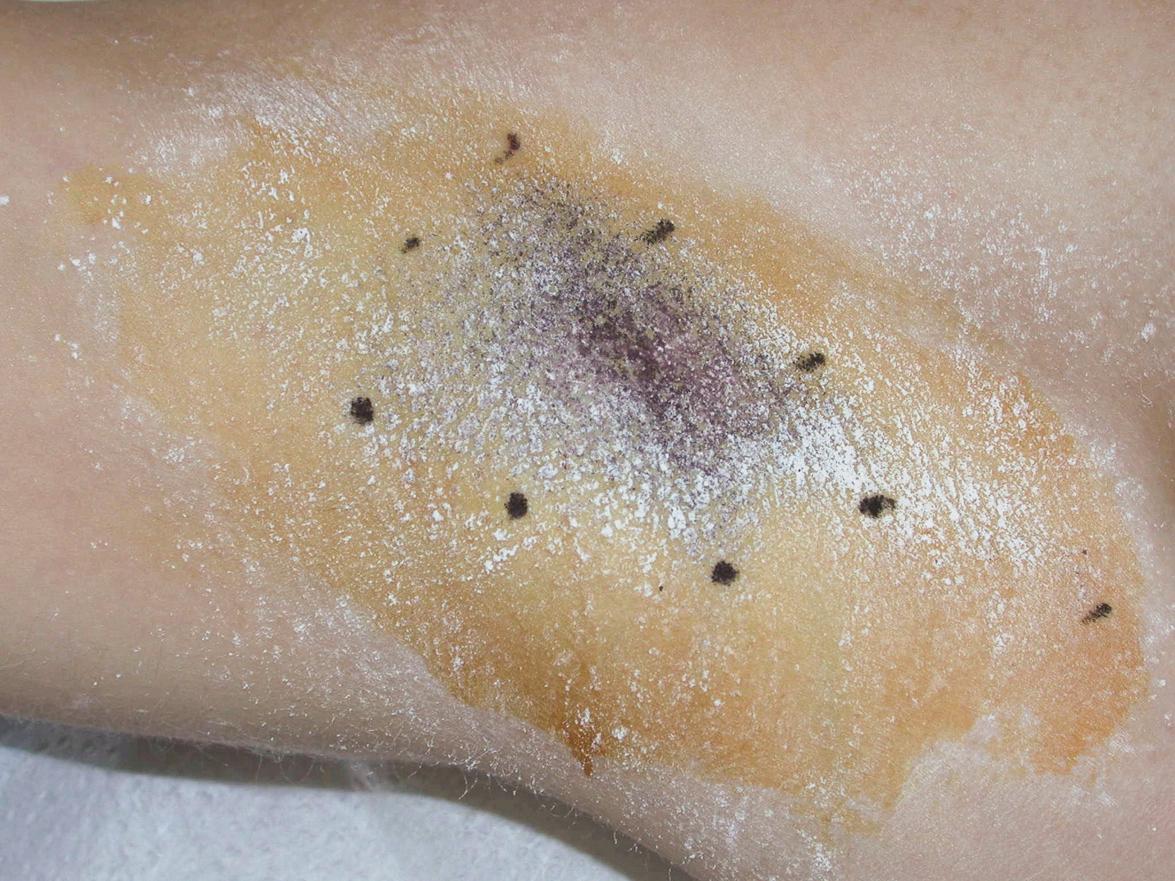
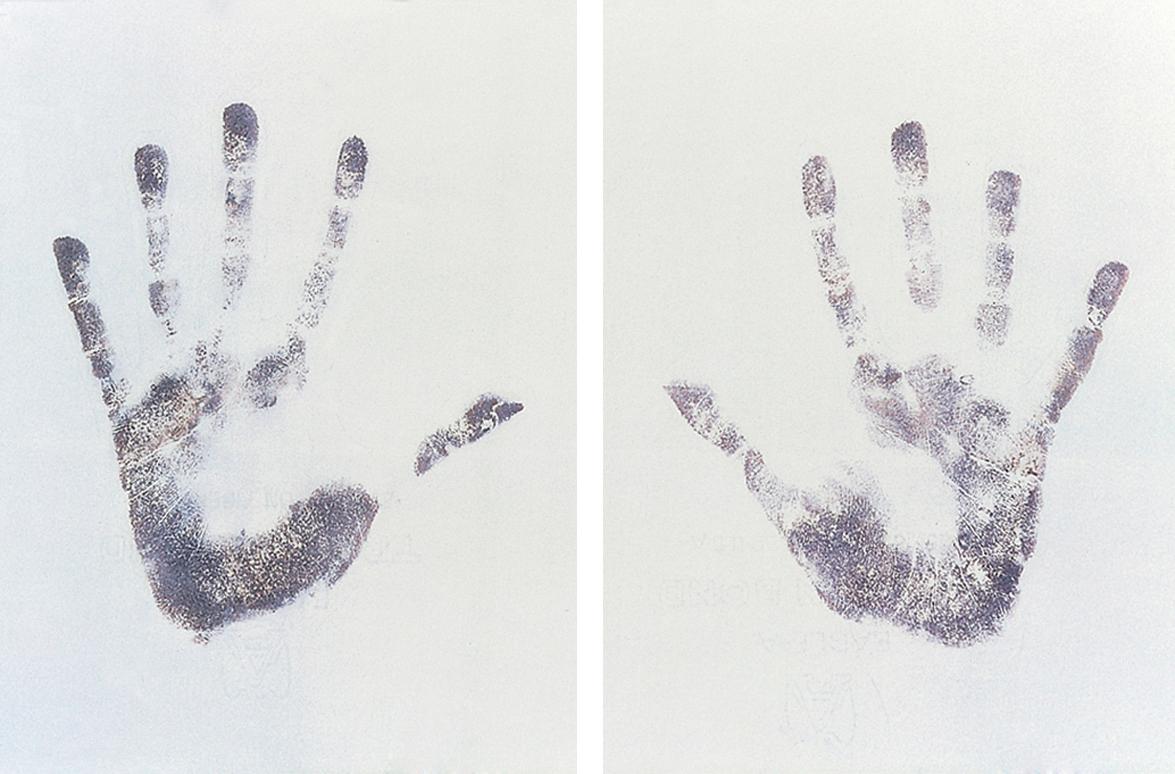
Additional quantitative assessment methods are available. In order to document amounts of sweat produced, gravimetric (via weighing filter paper before and after application to the skin) and evaporative (via a device that assesses water vapor loss from the skin) measurements can be made in volar or axillary sites . Infrared thermography represents another method of evaluating sweat gland function, allowing comparison between anatomic areas and even individual glands.
Become a Clinical Tree membership for Full access and enjoy Unlimited articles
If you are a member. Log in here